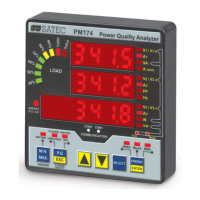60
3.7 Device Setup Registers
Address Point ID Description Options/Range Units Type R/W Notes
Device Identification
46080-46111
+0,1 Device serial number 0-999999 UINT32 R
+2,3 Device model ID 17400 UINT32 R
+4-11 Device model name “PM174” CHAR16 R Null-terminated string
+12-13 Device options (bitmap) 0 UINT32 R
+14-19 Reserved UINT16 R
+20 Device firmware version number 2400-2499 UINT16 R Two higher decimal digits = major
version number, two lower decimal
digits = minor version number
+21 Device firmware build number 1-99 UINT16 R
+22,23 Reserved UINT16 R
+24 Boot loader version number UINT16 R Two higher decimal digits = major
version number, two lower decimal
digits = minor version number
+25 Boot loader build number 1-99 UINT16 R
+26-31 Reserved UINT16 R
Factory Device Settings
46112-46178
+0 V1-V3 input range 690, 120 (option U) V UINT16 R Does not limit the 690V input range
+1 V1-V3 input overload 120 % UINT16 R
+2,3 Reserved UINT16 R
+4 I1-I3 input range 1, 5 A UINT16 R
+5 I1-I3 input overload 200 % UINT16 R
+6-13 Reserved UINT16 R
+13-63 Unused UINT16
+64 Ethernet MAC address 0-1 0x0500 UINT16 R
+65 Ethernet MAC address 2-3 0x00F0 UINT16 R
+66 Ethernet MAC address 4-5 0x0000-0xFFFF UINT16 R
Basic Setup
2304-2324
+0 Wiring mode F26 UINT16 R/W
+1 PT ratio 10 to 65000
×0.1
UINT16 R/W
+2 CT primary current 1 to 50,000 A UINT16 R/W
+3 Power block demand period 1,2,3,5,10,15,20,30,60 min,
255 = external synchronization
min UINT16 R/W If the external synchronization is
selected, the DI1 input is
considered a pulse or KYZ input.
The pulse edge restarts the power
demand block accumulation
interval.

